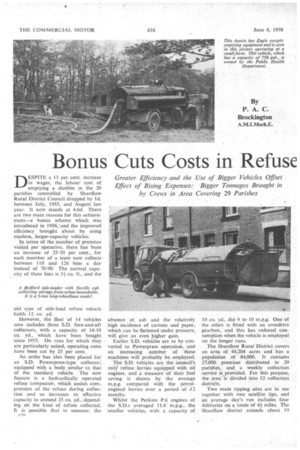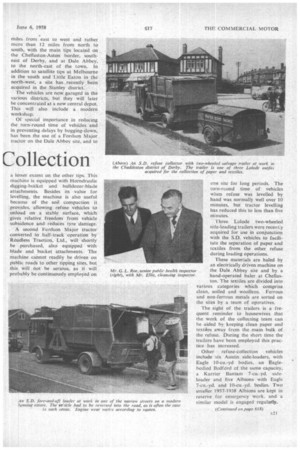Bonus Cuts Costs in Refuse Collection
Page 64

Page 65

Page 66

If you've noticed an error in this article please click here to report it so we can fix it.
By P. A. C. Brockington
A.M.I.Mech.E.
DESPITE a 13 per cent, increase in wages, the labour cost of emptying a dustbin in the 29 parishes controlled by Shardlow Rural District Council dropped by 1d. between July, 1955, and August last year. It now stands at 4.6d. There are two main reasons for this achievement—a bonus scheme which was introduced in 1956,'and the improved efficiency brought about by using modern, larger-capacity vehicles.
In terms of the number of premises visited per operative, there has been an increase of 25-30 per cent, for each member of a team now collects between 110 and 126 bins a day instead of 70-90. The normal capacity of these bins is 3-1 Cu. ft., and the old type of side-load refuse vehicle holds 12 cu. yd.
However, the fleet of 14 vehicles now includes three S.D. fore-and-aft collectors, with a capacity of 16-18 cu. yd., which have been bought since 1955. On runs for which they are particularly suited, operating costs have been cut by 25 per cent.
An order has also been placed for an S.D. Powerpress-type collector; equipped with a body similar to that of the standard vehicle. The new feature is a hydraulically operated refuse compactor, which assists compression of the refuse during collection and so increases its effective capacity to around 25 cu. yd., depending on the kind of refuse collected.
It is possible that in summer, the rIn absence of ash and the relatively high incidence of cartons and paper, which can be flattened under pressure, will give an even higher gain.
Earlier S.D. vehicles are to be converted to Powerpress operation, and an increasing number of "these machines will probably be employed.
The S.D. vehicles are the Council's only' refuse lorries equipped with oil engines, and a measure of their fuel saving is shown by the average m.p.g. compared with the petrolengined lorries over a period of -12 months.
Whilst the Perkins. P.6 engines of the S.D.s averaged 11.6 m.p.g., the smaller vehicles, with a capacity of 10 cu. yd„ did 9 to 10 m.p.g. One of the oilers is fitted with an overdrive gearbox, and this has reduced consumption when the vehicle is employed on the longer runs.
The Shardlow Rural District covers an area of 44,204 acres and has a population of 84,000. It contains 27,000 premises distributed in 29 parishes, and a weekly collection service is provided. For this purpose, the area is divided into 12 collection districts.
Two main tipping. sites are in use together with two satellite tips, and an average day's run includes four .1.1eliveries on a route of 4i miles. The Shardlow district. extends about 10 miles from east to west and rather more than 12 miles from north to south, with the main tips located on the Chellaston-Aston border, southeast of Derby, and at Dale Abbey, to the north-east of the town. In addition to satellite tips at Melbourne in the south and "Little Eaton in the north-west, a site has recently been acquired in the Stanley district.
The vehicles are now garaged in the various districts, but they will later be concentrated at a new central depot. This will also include a modern workshop.
Of special importance in reducing the turn-round time of vehicles and in preventing delays by bogging-down, has been the use of a Fordson Major tractor on the Dale Abbey site, and to a lesser extent on the other tips. This machine is equipped with Horndraulic digging-bucket and bulldozer-blade attachments. Besides its value for levelling, the machine is also useful because of the soil compaction it provides, allowing refuse vehicles to unload on a stable surface, which gives relative freedom from vehicle subsidence and reduces tyre damage.
A second Fordson Major tractor converted to half-track 'operation by Roadless Traction, Ltd., will shortly be purchased, also equipped with blade and bucket attachments. The machine cannot readily be driven on public roads to other tipping sites, but this will not be serious, as it will probably be continuously employed on one site for long periods. The turn-round time of • vehicles when refuse was levelled by hand was normally well over 10 minutes, but tractor levelling has reduced this to less than five minutes.
'Three Lolode two-wheeled side-loading trailers were recently acquired for use in conjunction with the S.D. vehicles to facilitate the separation of paper and textiles from the other refuse during loading operations.
These materials are baled by an electrically driven machine on the Dale Abbey site and by a hand-operated baler at Chellaston. The textiles are divided into various categories which comprise clean, soiled and woollens. Ferrous and non-ferrous metals are sorted on the sites by a team of operatives.
The sight of the trailers is a frequent reminder to housewives that the work of the collecting team can be aided by keeping clean paper and • textiles away from the main bulk of the refuse. During the short time the trailers have been employed this practice has increased.
Other refuse-collection vehicles include six Austin side-loaders, with Eagle 10-cu.-yd bodies, an Eaglebodied Bedford of the same capacity, a Karrier Bantam 7-cu.-yd. side loader and five Albions with Eagle 7-cu.-yd. and 10-cu.-yd. bodies. Two smaller 1937-1938 Albions are kept in reserve for emergency work, and a similar model is engaged regularly.
This vehicle has been driven by the same man for over 15 years.
Drivers of petrol-engined refuse collectors are given half a day every month to wash and service the vehicles and to perform minor repairs under the supervision of the head mechanic at the central workshops in Spondon. The S.D.s are serviced by drivers on a/weekly basis to ensure that the air filters have not been eloped during operations in a dust-laden atmosphere. In a hot summer, the filters are frequently cleaned twice a week.
Because the development of a Mechanical defect could reduce or eliminate the weekly bonus, the scheme encourages drivers and other operatives to lake care of their vehicles and to do repairs-inthe shortest possible time. The one-vehicle-one-team policy is strictly observed.
Run Over Kerbs Mr. G. L. Roe, the senior public health inspector, realizes that larger capacity • refuse collectors would increase efficiency, but they would not be as manceuvrable as the existing types in operation, and would cause obstruction. He is critical of carriageways on some new housing estates, where his vehicles already have to run over the kerbs, which can damage manholecoVers and cause unsightly ruts.
Mr. Roe therefore considers it would be impracticable to employ bodies of larger capacity than the S.D. vehicles have. On the use of semitrailers, he does not believe they would offer any advantage in normal operations, although the work of sorters on tipping sites would be reduced by the use of low-built trailers for loading salvaged scrap metal.
Up to 1932, refuse was collected by separate contractors on a yearly basis in all parishes, and in that year an attempt was made to improve operational efficiency by combining various parishes into groups and extending the contract period to three years. Tif 1937, the council started acquiring up-to-date vehicles for use by the contractors to improve the general standard of the fleet.
After 1941, war conditions made it impossible to continue the employment of contractors on a full-time basis, and it was found necessary progressively to introduce a system of direct control of all the operations. This was completed in 1947.
A high level of employmdit in the
area and the ready availability of factery work with a bonus payment caused labour troubles until the bonus scheme for collection personnel was introduced. An indication Of the success of the scheme in stabilizing labour conditions is shown by a comparison of the labour turnover in 1953 with that of the last financial year. Of 59 new employees taken on in 1953 only three continued in council's employ for more than a year, whereas the latest returns show a negligible -turnover.
Team Spirit More stable labour relations and the relatively few changes in personnel during the past 12 months have been important factors in improving the team spirit of the staff, and it is notable that fewer complaints were received last year than in previous years. As an average the weekly bonus is about 7s. for each man with Variations in exceptional circumstances up to £4.
The greater keenness and efficiency of the teams resulting from the introduction of the bonus scheme enabled the system to be based on weekly collections, and the success of the more regular working of the services is reflected in a substantial increase in the. amount of refuse collected.
Apart from the S.D. refuse collectors and the Fordson tractor, the only vehicle fitted with an oil engine in the council's combined fleet of 33 vehicles is a Morris-Commercial 1-ton van used by the Water Department. Two tipping vehicles are operated by the Public Health Department, both Austin 2-tonners of 1947-1948 manufacture, and the department also run five Morris-Commercial 5-cwt. vans, a breakdown crane based on an ex
Government Ford chassis, and an Austin 750-gal. cesspool emptier with Eagle equipment.
This machine is employed for a variety of operations, which includes collecting night soil from about 700 premises — mainly isolated farm houses and cottage's in small hamlets where public sewers are• not avail able. • Vehicles in the Surveyor's: Department consist of 12-cWt.: to 1-ton Bedford andMorris-Commercial vans and two Bedford 2-ton tippers, one. of which is equipped with a:manually operated gear.
Heavy-duty Supplement 1 .. lubricating oil of S.A.E. 30 Viscosity is used throughout the year in both oil engines and petrol units, a practice that has been proved to be beneficial to both types and which obviates filling engines with the incorrect grade of oil. The lubricant of petrol engines is changed every 3,000 miles, whilst the sumps of oil engines are replenished every 2,000 miles.
Big Differences in Life The wearing life of the engine and major chassis 'components varies greatly according to the route on which the vehicle is used and the capabilities of the driver. Overhauls are therefore performed when recommended by the head mechanic.
A provisional monthly repair schedule is arranged beforehand in consultation with Mr. Roe. The workshop staff consists of two fully qualified mechanics, a semi-skilled mechanic and an apprentice.
On average, the power units of petrol-engined refuse vehicles run for about two years before an overhaul is necessitated by heavy oil consumption.








































































































































